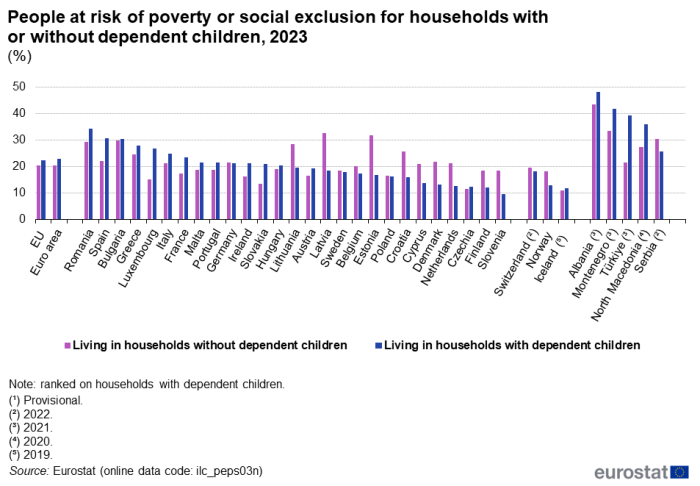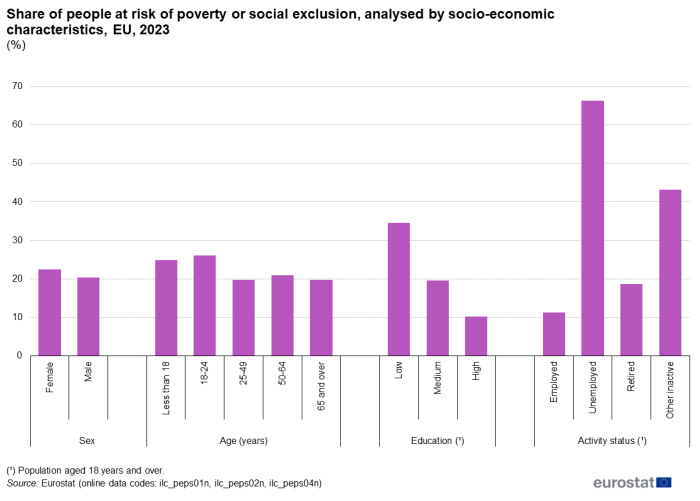Key findings
In 2023, 21.4 % of the EU population — or some 94.6 million people — were at risk of poverty or social exclusion.
The risk of poverty and social exclusion is not dependent strictly on a household‘s level of income, as it may also reflect joblessness, low work intensity, working status, or a range of other socio-economic characteristics. To calculate the number or share of people who are at risk of poverty or social exclusion three separate measures are combined and this covers those people who are in at least one of these three situations:
- people who are at risk of poverty, in other words, with an equivalised disposable income that is below the at-risk-of-poverty threshold;
- people who suffer from severe material and social deprivation, in other words, those who cannot afford at least seven out of thirteen deprivation items (six related to the individual and seven related to the household) that are considered by most people to be desirable or even necessary to lead an adequate quality of life;
- people (aged less than 65 years) living in a household with very low work intensity, in other words, those living in households where adults worked for 20 % or less of their total combined work-time potential during the previous twelve months.
In 2023, the risk of poverty or social exclusion was greater across the EU for women (rather than men), young adults (rather than middle-aged or elderly individuals), people with a low level of educational attainment (rather than those with a medium or tertiary level of educational attainment) and, in particular, for unemployed people.
- Over one-fifth of the EU population living in households with dependent children were at risk of poverty or social exclusion in 2023 and the risk of poverty or social exclusion was slightly lower among households without dependent children.
- Working status was unsurprisingly one of the main socio-economic characteristics that impacted upon the risk of poverty or social exclusion. In 2023, while the risk of poverty or social exclusion in the EU was 11.3 % for employed persons and 18.7 % for retired people, it was almost two-thirds (66.3 %) for unemployed people and stood at 43.2 % for other inactive people, in other words those who — for a reason other than retirement — were not working or unemployed.
- The risk of poverty or social exclusion varied considerably across the EU Member States. Romania (32.0 %), Bulgaria (30.0 %) and Spain (26.5 %) reported the highest shares of people at risk of poverty and social exclusion in 2023. By contrast, Finland, Slovenia and Czechia presented shares below 16.0 % (EU value being 21.4 %).
Poverty and social exclusion
Over one in five people in the EU were at risk of poverty or social exclusion
In 2023, there were around 94.6 million people in the EU at risk of poverty or social exclusion, which was equivalent to 21.4 % of the total population. The number of people at risk of poverty or social exclusion, which may be abbreviated as “AROPE”, corresponds to the sum of people who are (i) at risk of poverty (as indicated by their disposable income); and/or (ii) face severe material and social deprivation (as gauged by their ability to afford a set of predefined material items or social activities); and/or (iii) live in a household with very low work intensity.
Component indicators which contribute to an analysis of the risk of poverty or social exclusion
Figure 1 provides an analysis for the EU population of the various risks of poverty or social exclusion. Among the 94.6 million inhabitants within the EU that faced the risk of poverty or social exclusion in 2023, some 5.5 million lived in households experiencing simultaneously all three poverty and social exclusion risks. There were 11.2 million people in the EU living both at risk of poverty and in a household with very low work intensity (but not severely materially and socially deprived); 8.9 million were at risk of poverty and at the same time severely materially and socially deprived (but not in a household with very low work intensity); almost 2.0 million lived in households with very low work intensity while experiencing severe material deprivation (but were not at risk of poverty).
Source: Eurostat (ilc_pees01n)
The profile of people in the EU at risk of poverty or social exclusion
Women, young adults aged 18-24 years, people with a low level of educational attainment and unemployed people were, on average, more likely to be at risk of poverty or social exclusion in 2023 than other groups within the EU population (see Figure 2).
Women and young adults were more at risk of poverty or social exclusion
When analyzed by sex, the risk of poverty or social exclusion in the EU was higher for women than it was for men (22.4 % compared with 20.3 %).
Concerning age, the highest risk of poverty or social exclusion in the EU was recorded for young adults aged 18-24 years (26.1 %), while the lowest risk was recorded for adults aged 25-49 years (19.7 %). Moreover, the risk of poverty or social exclusion was 19.8 % for people aged 65 years and over and 20.9 % among the population aged 50-64 years. The youngest age group, persons aged less than 18 years, also had a relatively high risk (24.8 %).
In addition to age, educational attainment had a considerable impact on the risk of poverty or social exclusion
At EU level, more than one-third (34.5 %) of all people aged 18 years and over with a low level of educational attainment (ISCED levels 0-2) were at risk of poverty or social exclusion, compared with 10.2 % of people in the same age group with a tertiary (high) level of educational attainment (ISCED levels 5-8). The corresponding percentage for people with a medium level of educational attainment (ISCED levels 3-4) was 19.6 %.
Unemployed people faced a particularly high risk of poverty or social exclusion
In the EU, 66.3 % of the unemployed aged 18 years and over were at risk of poverty or social exclusion in 2023. Inactive people (other than in retirement) faced the second-highest risk on the basis of an analysis by activity status, with 43.2 % at risk. For comparison, the share of people in retirement who were at risk of poverty or social exclusion was 18.7 % and the share of employed persons in such situation was 11.3 %.
At the EU level, the risk of poverty or social exclusion for households with dependent children was a little higher than for those without
More than one-fifth (22.4 %) of people living in households with dependent children in the EU were at risk of poverty or social exclusion which was slightly higher than the respective share among households without dependent children (20.4 %). Nevertheless, these rates varied considerably across the EU Member States. For people living in households with dependent children, the rate ranged from peaks of 34.2 % in Romania, 30.7 % in Spain and 30.3 % in Bulgaria down to 12.4 % in Czechia, 12.1 % in Finland and 9.6 % in Slovenia (see Figure 3).
For those living in households without dependent children, the rates varied from 32.6 % in Latvia, 31.6 % in Estonia, 29.7 % in Bulgaria to 14.9 % in Luxembourg, 13.5 % in Slovakia and 11.5 % in Czechia.

Source: Eurostat (ilc_peps03n)
Context
At risk of poverty or social exclusion, abbreviated as AROPE, corresponds to the sum of people who are either at risk of poverty, or severely materially and socially deprived or living in a household with a very low work intensity. People are included only once even if they are in more than one of these situations. The AROPE ratio is the share of the total population which is at risk of poverty or social exclusion.
The headline target (EU2030 target) on poverty and social inclusion of the European Pillar of Social Rights Action Plan is to reduce the number of people at risk of poverty or social exclusion by at least 15 million by 2030. Progress towards this target is monitored through the AROPE rate, published by Eurostat.
In 2021, the AROPE indicator was modified. The severe material deprivation rate component was revised, defining a new severe material and social deprivation rate (SMSD) based on a revised list of items, and the low work intensity indicator relating to people living in a household with a very low work intensity was redefined. The revised AROPE indicator is used to monitor the headline target on poverty and social inclusion of the European Pillar of Social Rights Action Plan.


